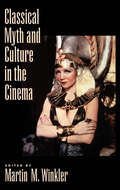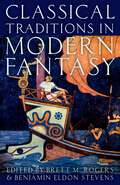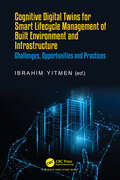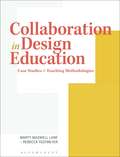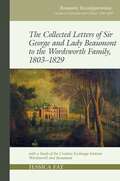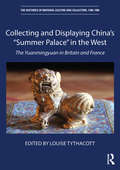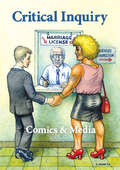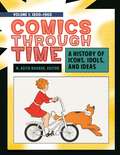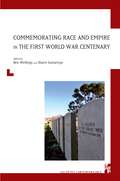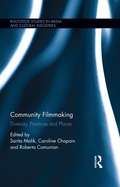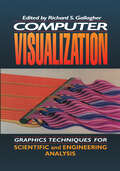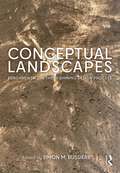- Table View
- List View
Classical Myth and Culture in the Cinema
Classical Myth and Culture in the Cinema is a collection of essays presenting a variety of approaches to films set in ancient Greece and Rome and to films that reflect archetypal features of classical literature. The diversity of content and theoretical stances found in this volume will make it required reading for scholars and students interested in interdisciplinary approaches to text and image, and for anyone interested in the presence of Greece and Rome in modern popular culture.
Classical Traditions in Modern Fantasy
Classical Traditions in Modern Fantasy is the first collection of essays in English focusing on how fantasy draws deeply on ancient Greek and Roman mythology, philosophy, literature, history, art, and cult practice. Presenting fifteen all-new essays intended for both scholars and other readers of fantasy, this volume explores many of the most significant examples of the modern genre-including the works of H. P. Lovecraft, J. R. R. Tolkien's The Hobbit, C. S. Lewis's Chronicles of Narnia, J. K. Rowling's Harry Potter series, George R. R. Martin's Game of Thrones series, and more-in relation to important ancient texts such as Aeschylus' Oresteia, Aristotle's Poetics, Virgil's Aeneid, and Apuleius' The Golden Ass. These varied studies raise fascinating questions about genre, literary and artistic histories, and the suspension of disbelief required not only of readers of fantasy but also of students of antiquity. Ranging from harpies to hobbits, from Cyclopes to Cthulhu, and all manner of monster and myth in-between, this comparative study of Classics and fantasy reveals deep similarities between ancient and modern ways of imagining the world. Although antiquity and the present day differ in many ways, at its base, ancient literature resonates deeply with modern fantasy's image of worlds in flux and bodies in motion.
Clown riding a 'Giraffe' unicycle (Large Print)
This is an image of a circus clown riding a one-wheeled cycle in the middle of the page. He is facing to the right with only one eye visible. There is a locator dot shown, which will be at the top left of the page when the image is the right way up. At the top centre of the page is the clown's little bowler hat sitting on his long hair. Just to the right of this is his face seen from the side with one eye, his comedy red nose and his big wide mouth. His arms are thrown out wide to the left and right from his right-facing body and down the page from this is his bottom sitting on the seat of the unicycle. Down the page again is the frame of the cycle with the clown's legs to the left and right and his feet in enormous clown boots on the pedals of the machine. His foot to the left is behind the arm of the pedal. At the bottom of the page is the cycle's wheel, connected to the pedals by a chain.
Clown riding a 'Giraffe' unicycle (UEB Contracted)
This is an image of a circus clown riding a one-wheeled cycle in the middle of the page. He is facing to the right with only one eye visible. There is a locator dot shown, which will be at the top left of the page when the image is the right way up. At the top centre of the page is the clown's little bowler hat sitting on his long hair. Just to the right of this is his face seen from the side with one eye, his comedy red nose and his big wide mouth. His arms are thrown out wide to the left and right from his right-facing body and down the page from this is his bottom sitting on the seat of the unicycle. Down the page again is the frame of the cycle with the clown's legs to the left and right and his feet in enormous clown boots on the pedals of the machine. His foot to the left is behind the arm of the pedal. At the bottom of the page is the cycle's wheel, connected to the pedals by a chain.
Clown riding a 'Giraffe' unicycle (UEB uncontracted)
This is an image of a circus clown riding a one-wheeled cycle in the middle of the page. He is facing to the right with only one eye visible. There is a locator dot shown, which will be at the top left of the page when the image is the right way up. At the top centre of the page is the clown's little bowler hat sitting on his long hair. Just to the right of this is his face seen from the side with one eye, his comedy red nose and his big wide mouth. His arms are thrown out wide to the left and right from his right-facing body and down the page from this is his bottom sitting on the seat of the unicycle. Down the page again is the frame of the cycle with the clown's legs to the left and right and his feet in enormous clown boots on the pedals of the machine. His foot to the left is behind the arm of the pedal. At the bottom of the page is the cycle's wheel, connected to the pedals by a chain.
Cognitive Digital Twins for Smart Lifecycle Management of Built Environment and Infrastructure: Challenges, Opportunities and Practices
This book provides knowledge into Cognitive Digital Twins for smart lifecycle management of built environment and infrastructure focusing on challenges and opportunities. It focuses on the challenges and opportunities of data-driven cognitive systems by integrating the heterogeneous data from multiple resources that can easily be used in a machine learning model and adjust the algorithms. It comprises Digital Twins incorporating cognitive features that will enable sensing complex and unpredicted behavior and reason about dynamic strategies for process optimization to support decision-making in lifecycle management of the built environment and infrastructure. The book introduces the Knowledge Graph (KG)-centric framework for Cognitive Digital Twins involving process modeling and simulation, ontology-based Knowledge Graph, analytics for process optimizations, and interfaces for data operability. It offers contributions of Cognitive Digital Twins for the integration of IoT, Big data, AI, smart sensors, machine learning and communication technologies, all connected to a novel paradigm of self-learning hybrid models with proactive cognitive capabilities. The book presents the topologies of models described for autonomous real time interpretation and decision-making support of complex system development based on Cognitive Digital Twins with applications in critical domains such as maintenance of complex engineering assets in built environment and infrastructure. It offers the essential material to enlighten pertinent research communities of the state-of-the-art research and the latest development in the area of Cognitive Digital Twins, as well as a valuable reference for planners, designers, developers, and ICT experts who are working towards the development and implementation of autonomous Cognitive IoT based on big data analytics and context–aware computing.
Collaboration in Design Education
The book is a comprehensive guide for students and practitioners who want to take a collaborative approach in their design practice. Authors Marty Maxwell Lane and Rebecca Tegtmeyer introduce a range of case study collaborations, both face-to-face and remote, and between individuals and groups. The book addresses the basics of getting started, planning ahead and reflecting on outcomes, alongside the issues that come up in collaborative work, e.g. cross-cultural exchange, or managing roles within a diverse team. Editorial commentary runs throughout the chapter introductions and case studies, with informatics illustrating key concepts and expanded 'call out' points in the martin. More complex case studies offer a 'deep dive' section to explain and share further details of the featured projects.
The Collected Letters of Sir George and Lady Beaumont to the Wordsworth Family, 1803–1829: with a Study of the Creative Exchange between Wordsworth and Beaumont (Romantic Reconfigurations: Studies in Literature and Culture 1780-1850 #14)
Sir George Beaumont is a key figure in the history of British art. As well as being a respected amateur landscape painter, he was a prominent patron, a collector, and co-founder of the National Gallery. William Wordsworth described Beaumont’s friendship as one of the chief blessings of his life, and this edition reveals that the two men became collaborators as well as companions. In addition to documenting unique perspectives on social, political, and cultural events of the early nineteenth century (providing new contexts for reading Wordsworth’s mature poetry), the letters collected here chart the progress of an increasingly intimate inter-familial relationship. The picture that emerges is of a coterie that – in influence, creativity, and affection – rivals Wordsworth’s more famous exchange with Coleridge at Nether Stowey in the 1790s. The edition includes an extended study of how Wordsworth and Beaumont helped shape one another’s work, tracing processes of mutual artistic development that involved not only a meeting of aristocratic refinement and rural simplicity, of a socialite and a lover of retirement, of a painter and a poet, but also an aesthetic rapprochement between neoclassical and romantic values, between the impulse to idealize and the desire to particularize.
Collecting and Displaying China's “Summer Palace” in the West: The Yuanmingyuan in Britain and France (The Histories of Material Culture and Collecting, 1700-1950)
In October 1860, at the culmination of the Second Opium War, British and French troops looted and destroyed one of the most important palace complexes in imperial China—the Yuanmingyuan. Known in the West as the "Summer Palace," this site consisted of thousands of buildings housing a vast art collection. It is estimated that over a million objects may have been taken from the palaces in the Yuanmingyuan—and many of these are now scattered around the world, in private collections and public museums. With contributions from leading specialists, this is the first book to focus on the collecting and display of "Summer Palace" material over the past 150 years in museums in Britain and France. It examines the way museums placed their own cultural, political and aesthetic concerns upon Yuanmingyuan material, and how displays—especially those at the Royal Engineers Museum in Kent, the National Museum of Scotland and the Musée Chinois at the Château of Fontainebleau—tell us more about European representations and images of China, than they do about the Yuanmingyuan itself.
Collecting Prints, Posters, and Ephemera: Perspectives in a Global World (Contextualizing Art Markets)
Why did collectors seek out posters and collect ephemera during the late-nineteenth and the twentieth centuries? How have such materials been integrated into institutional collections today? What inspired collectors to build significant holdings of works from cultures other than their own? And what are the issues facing curators and collectors of digital ephemera today? These are among the questions tackled in this volume-the first to examine the practices of collecting prints, posters, and ephemera during the modern and contemporary periods. A wide range of case studies feature collections of printed materials from the United States, Latin America, France, Germany, Great Britain, China, Japan, Russia, Iran, and Cuba. Fourteen essays and one roundtable discussion, all specially commissioned from art historians, curators, and collectors for this volume, explore key issues such as the roles of class, politics, and gender, and address historical contexts, social roles, value, and national and transnational aspects of collecting practices. The global scope highlights cross-cultural connections and contributes to a new understanding of the place of prints, posters and ephemera within an increasingly international art world.
Colonial-Era Caribbean Theatre: Issues in Research, Writing and Methodology
Cutting across academic boundaries, this volume brings together scholars from different disciplines who have explored together the richness and complexity of colonial-era Caribbean theatre. The volume offers a series of original essays that showcase individual expertise in light of broader group discussions. Asking how we can research effectively and write responsibly about colonial-era Caribbean theatre today, our primary concern is methodology. Key questions are examined via new research into individual case studies on topics ranging from Cuban blackface, commedia dell’arte in Suriname and Jamaican oratorio to travelling performers and the influence of the military and of enslaved people on theatre in Saint-Domingue. Specifically, we ask what particular methodological challenges we as scholars of colonial-era Caribbean theatre face and what methodological solutions we can find to meet those challenges. Areas addressed include our linguistic limitations in the face of Caribbean multilingualism; issues raised by national, geographical or imperial approaches to the field; the vexed relationship between metropole and colony; and, crucially, gaps in the archive. We also ask what implications our findings have for theatre performance today – a question that has led to the creation of a new work set in a colonial theatre and outlined in the volume’s concluding chapter.
Color and Victorian Photography (Key Texts in Victorian Photography)
Nineteenth-century photography is usually thought of in terms of ‘black and white’ images, but intense experimentation with generating and fixing colors pre-dated the public announcement of the daguerreotype in 1839. Introducing readers to the long, frequently overlooked story of the relationship of color to photography, this short anthology of primary sources includes: accounts of the scientific search for color by Elizabeth Fulhame and Sir John Herschel;photographers' views on color; extracts from the photographic press and from manuals on handcoloring; and accounts by critics such as John Ruskin. The volume provides a fresh perspective on the culture, history and theory of early photography, demonstrating why scientists, philosophers, photographers, literary writers and artists were so fascinated by the potential for polychrome in photographs. With an introductory essay arguing that from the earliest days of photography the prospect of color loomed large in the imagination of its creators, users and critics, this reader is an essential resource for students and scholars wanting to gain a full understanding of nineteenth-century photography and its relationship to art history, literature and culture.
The Colosseum, Rome - Multipage image (Large Print)
This is a set of images of the Colosseum amphitheatre in Rome, Italy; it comprises a page of keys, a plan, and a cross section. It is a multipage image set on three pages. There is a locator dot shown, which will be at the top left of the page when the image is the right way up. Rome: keys for plan and cross section - These keys show the features and the abbreviations used on the plan and cross section pages. The top of the page refers to the plan and the features of the cross section are on the bottom of the page.Colosseum, Rome - plan of upper and ground floor: This page shows a plan view of the Colosseum (seen from above) with a scale shown in the top left. The structure is four stories high and oval shaped. It slopes down from the full height of the supporting piers at its circumference to the arena floor at ground level, in the centre of the page. Tiers of seating surround the arena. The gaps between the seating represent the entrances to the internal stairs leading down to ground-level access. The bottom left quarter of the plan has been cut away to show the internal supporting walls of the building. There are many underground passages and rooms beneath the building; these have not been shown. They housed people and animals taking part in the staged events as well as props, scenery and special effects. There was access from them to the arena floor through hidden trapdoors.Colosseum, Rome - cross section of one side - This page shows a cut-away view of one side of the Colosseum. There are labels on the left of the page with leader lines pointing to the floors of the building on the right. At the bottom left of the page is the arena floor. To the right of this the ground floor can be found with the tiers of seating going diagonally up the page from it. Down the page from the seating is the cut-away view of the inside of the building, showing the supporting pillars and the stairs to the upper levels.
The Colosseum, Rome - Multipage image (UEB Contracted)
This is a set of images of the Colosseum amphitheatre in Rome, Italy; it comprises a page of keys, a plan, and a cross section. It is a multipage image set on three pages. There is a locator dot shown, which will be at the top left of the page when the image is the right way up. Rome: keys for plan and cross section - These keys show the features and the abbreviations used on the plan and cross section pages. The top of the page refers to the plan and the features of the cross section are on the bottom of the page.Colosseum, Rome - plan of upper and ground floor: This page shows a plan view of the Colosseum (seen from above) with a scale shown in the top left. The structure is four stories high and oval shaped. It slopes down from the full height of the supporting piers at its circumference to the arena floor at ground level, in the centre of the page. Tiers of seating surround the arena. The gaps between the seating represent the entrances to the internal stairs leading down to ground-level access. The bottom left quarter of the plan has been cut away to show the internal supporting walls of the building. There are many underground passages and rooms beneath the building; these have not been shown. They housed people and animals taking part in the staged events as well as props, scenery and special effects. There was access from them to the arena floor through hidden trapdoors.Colosseum, Rome - cross section of one side - This page shows a cut-away view of one side of the Colosseum. There are labels on the left of the page with leader lines pointing to the floors of the building on the right. At the bottom left of the page is the arena floor. To the right of this the ground floor can be found with the tiers of seating going diagonally up the page from it. Down the page from the seating is the cut-away view of the inside of the building, showing the supporting pillars and the stairs to the upper levels.
The Colosseum, Rome - Multipage image (UEB Uncontracted)
This is a set of images of the Colosseum amphitheatre in Rome, Italy; it comprises a page of keys, a plan, and a cross section. It is a multipage image set on three pages. There is a locator dot shown, which will be at the top left of the page when the image is the right way up. Rome: keys for plan and cross section - These keys show the features and the abbreviations used on the plan and cross section pages. The top of the page refers to the plan and the features of the cross section are on the bottom of the page.Colosseum, Rome - plan of upper and ground floor: This page shows a plan view of the Colosseum (seen from above) with a scale shown in the top left. The structure is four stories high and oval shaped. It slopes down from the full height of the supporting piers at its circumference to the arena floor at ground level, in the centre of the page. Tiers of seating surround the arena. The gaps between the seating represent the entrances to the internal stairs leading down to ground-level access. The bottom left quarter of the plan has been cut away to show the internal supporting walls of the building. There are many underground passages and rooms beneath the building; these have not been shown. They housed people and animals taking part in the staged events as well as props, scenery and special effects. There was access from them to the arena floor through hidden trapdoors.Colosseum, Rome - cross section of one side - This page shows a cut-away view of one side of the Colosseum. There are labels on the left of the page with leader lines pointing to the floors of the building on the right. At the bottom left of the page is the arena floor. To the right of this the ground floor can be found with the tiers of seating going diagonally up the page from it. Down the page from the seating is the cut-away view of the inside of the building, showing the supporting pillars and the stairs to the upper levels.
Comics & Media: A Special Issue of "Critical Inquiry" (A Critical Inquiry Book)
The past decade has seen the medium of comics reach unprecedented heights of critical acclaim and commercial success. Comics & Media reflects that, bringing together an amazing array of contributors--creators and critics alike--to discuss the state, future, and potential of the medium. Loaded with full-color reproductions of work by such legends as R. Crumb, Art Spiegelman, Alison Bechdel, Chris Ware, Daniel Clowes, and Lynda Barry, the book addresses the place of comics in both a contemporary and historical context. Essays by such high-profile figures as Tom Gunning, N. Katherine Hayles, Patrick Jagoda, and W. J. T. Mitchell address a stunning range of topics, including the place of comics in the history of aesthetics, changes to popular art forms, digital humanities, and ongoing tensions between new and old media. The result is a substantial step forward for our understanding of what comics are and can be, and the growing place they hold in our culture.
Comics through Time [4 volumes]: A History of Icons, Idols, and Ideas [4 volumes]
Focusing especially on American comic books and graphic novels from the 1930s to the present, this massive four-volume work provides a colorful yet authoritative source on the entire history of the comics medium.Comics and graphic novels have recently become big business, serving as the inspiration for blockbuster Hollywood movies such as the Iron Man series of films and the hit television drama The Walking Dead. But comics have been popular throughout the 20th century despite the significant effects of the restrictions of the Comics Code in place from the 1950s through 1970s, which prohibited the depiction of zombies and use of the word "horror," among many other rules. Comics through Time: A History of Icons, Idols, and Ideas provides students and general readers a one-stop resource for researching topics, genres, works, and artists of comic books, comic strips, and graphic novels. The comprehensive and broad coverage of this set is organized chronologically by volume. Volume 1 covers 1960 and earlier; Volume 2 covers 1960–1980; Volume 3 covers 1980–1995; and Volume 4 covers 1995 to the present. The chronological divisions give readers a sense of the evolution of comics within the larger contexts of American culture and history. The alphabetically arranged entries in each volume address topics such as comics publishing, characters, imprints, genres, themes, titles, artists, writers, and more. While special attention is paid to American comics, the entries also include coverage of British, Japanese, and European comics that have influenced illustrated storytelling of the United States or are of special interest to American readers.
Commemorating Race and Empire in the First World War Centenary (Provence University Press)
First World War commemoration in Europe has been framed as a moment of national trial and as a collective European tragedy. But the ‘Great War for Civilisation’ was more than just a European conflict. It was in fact a global war, a clash of empires that began a process of nationalist agitation against imperial polities and the racisms that underpinned them in Asia, Africa and beyond. Despite the global context of Centenary commemorative activity these events remain framed by national and state imaginaries and ones in which the ideas about nation, race and imperialism that animated and dominated men and women during the Great War sit uncomfortably with modern sensibilities. By drawing on original archival research, translations from French and Mandarin into English and by employing multidisciplinary conceptual frames of analysis this exciting and innovative volume explores how race and empire, and racism and imperialism, were commemorated or forgotten during the First World War Centenary.
Communities and Museums in the 21st Century: Shared Histories and Climate Action (ICOM Advances in Museum Research)
Communities and Museums in the 21st Century brings together innovative, multidisciplinary perspectives on contemporary museology and participatory museum practice that contribute to wider debates on museum communities, heritage, and sustainability. Set within the context of globalisation and decolonisation, this book draws upon bi-regional research that will enrich our understanding of the complex relationships between Europe, Latin America and the Caribbean through museum studies and practice. Chapters reflect upon the role of museums in defining community identities; the importance of young people’s participation and intergenerational work for sustainability; the role of museums in local development; and community-based museums and climate change. Contributors examine these issues through the lens of museum partnerships and practices, as well as testing the continued relevance of the notion of ‘integral museum’ and its relatives in the form of ecomuseums. With its focus on regional museums in Latin America and Caribbean, this book highlights how the case studies promote greater intercultural dialogue, global understanding and social cohesion. It also demonstrates how the methodology can be adapted to other communities who are facing the perils of climate change and unsustainable forms of development. Communities and Museums in the 21st Century proposes creative and sustainable strategies relevant to a globalised future. With its focus on global societal challenges, this book will appeal to museologists and museum practitioners, as well as those working in heritage studies, cultural studies, memory studies, art history, gender studies, and sustainable development.
Community Filmmaking: Diversity, Practices and Places (Routledge Studies in Media and Cultural Industries)
This book examines the role of community filmmaking in society and its connection with issues of cultural diversity, innovation, policy and practice in various places. Deploying a range of examples from Europe, North America, Australia and Hong Kong, the chapters show that film emerging from outside the mainstream film industries and within community contexts can lead to innovation in terms of both content and processes and a better representation of the cultural diversity of a range of communities and places. The book aims to situate the community filmmaker as the central node in the complex network of relationships between diverse communities, funding bodies, policy and the film industries.
A Companion to British-Jewish Theatre Since the 1950s (Methuen Drama Engage)
The first of its kind, this companion to British-Jewish theatre brings a neglected dimension in the work of many prominent British theatre-makers to the fore. Its structure reflects the historical development of British-Jewish theatre from the 1950s onwards, beginning with an analysis of the first generation of writers that now forms the core of post-war British drama (including Tom Stoppard, Harold Pinter and Arnold Wesker) and moving on to significant thematic force-fields and faultlines such as the Holocaust, antisemitism and Israel/Palestine. The book also covers the new generation of British-Jewish playwrights, with a special emphasis on the contribution of women writers and the role of particular theatres in the development of British-Jewish theatre, as well as TV drama. Included in the book are fascinating interviews with a set of significant theatre practitioners working today, including Ryan Craig, Patrick Marber, John Nathan, Julia Pascal and Nicholas Hytner. The companion addresses, not only aesthetic and ideological concerns, but also recent transformations with regard to institutional contexts and frameworks of cultural policies.
The Complete Lyrics of Alan Jay Lerner
Alan Jay Lerner wrote the lyrics for some of the most beloved musicals in Broadway and Hollywood history. Most notably, with composer Frederick Loewe he created enduring hits such as My Fair Lady, Gigi, Camelot, and Brigadoon. In The Complete Lyrics of Alan Jay Lerner, editors and annotators Dominic McHugh and Amy Asch bring all of Lerner's lyrics together for the first time, including numerous draft or alternate versions and songs cut from the shows. Compiled from dozens of archival collections, this invaluable resource and authoritative reference includes both Lerner's classic works and numerous discoveries, including his unproduced MGM movie Huckleberry Finn, selections from his college musicals, and lyrics from three different versions of Paint Your Wagon. This collection also includes extensive material from Lerner's two most ambitious musicals: Love Life, to music by Kurt Weill, and 1600 Pennsylvania Avenue, which Lerner wrote with Leonard Bernstein.
Computer Vision: Challenges, Trends, and Opportunities (Chapman & Hall/CRC Computer Vision)
Computer vision has made enormous progress in recent years, and its applications are multifaceted and growing quickly, while many challenges still remain. This book brings together a range of leading researchers to examine a wide variety of research directions, challenges, and prospects for computer vision and its applications.This book highlights various core challenges as well as solutions by leading researchers in the field. It covers such important topics as data-driven AI, biometrics, digital forensics, healthcare, robotics, entertainment and XR, autonomous driving, sports analytics, and neuromorphic computing, covering both academic and industry R&D perspectives. Providing a mix of breadth and depth, this book will have an impact across the fields of computer vision, imaging, and AI.Computer Vision: Challenges, Trends, and Opportunities covers timely and important aspects of computer vision and its applications, highlighting the challenges ahead and providing a range of perspectives from top researchers around the world. A substantial compilation of ideas and state-of-the-art solutions, it will be of great benefit to students, researchers, and industry practitioners.
Computer Visualization: Graphics Techniques for Engineering and Scientific Analysis
Rapid advances in 3-D scientific visualization have made a major impact on the display of behavior. The use of 3-D has become a key component of both academic research and commercial product development in the field of engineering design. Computer Visualization presents a unified collection of computer graphics techniques for the scientific visualization of behavior. The book combines a basic overview of the fundamentals of computer graphics with a practitioner-oriented review of the latest 3-D graphics display and visualization techniques. Each chapter is written by well-known experts in the field. The first section reviews how computer graphics visualization techniques have evolved to work with digital numerical analysis methods. The fundamentals of computer graphics that apply to the visualization of analysis data are also introduced. The second section presents a detailed discussion of the algorithms and techniques used to visualize behavior in 3-D, as static, interactive, or animated imagery. It discusses the mathematics of engineering data for visualization, as well as providing the current methods used for the display of scalar, vector, and tensor fields. It also examines the more general issues of visualizing a continuum volume field and animating the dimensions of time and motion in a state of behavior. The final section focuses on production visualization capabilities, including the practical computational aspects of visualization such as user interfaces, database architecture, and interaction with a model. The book concludes with an outline of successful practical applications of visualization, and future trends in scientific visualization.
Conceptual Landscapes: Fundamentals in the Beginning Design Process
Conceptual Landscapes explores the dilemma faced in the early moments of design thinking through a gradient of work in landscape and environmental design media by both emerging and well-established designers and educators of landscape architecture. It questions where and, more importantly, how the process of design starts. The book deconstructs the steps of conceptualizing design in order to reignite pedagogical discussions about timing and design fundamentals, and to reveal how the spark of an idea happens – from a range of unique perspectives. Through a careful arrangement of visual essays that integrate analog, digital, and mixed-media works and processes, the book highlights differences between diverse techniques and triggers debate between design, representation, technology, and creative culture in the field. Taken together, the book’s visual investigation of the conceptual design process serves as a learning tool for aspiring designers and seasoned professionals alike. By situating student work alongside that of experienced teachers and landscape architects, the book also demystifies outdated notions of individual genius and sheds new light on the nearly universally messy process of discovery, bridged across years and diverse creative vocabularies in the conceptual design process. Lavishly illustrated with over 210 full color images, this book is a must-read for students and instructors in landscape architecture.
